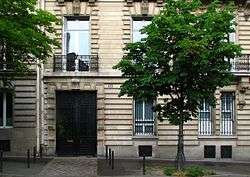French School of the Far East
The French School of the Far East (French: École française d'Extrême-Orient, pronounced [ekɔl fʁɑ̃sɛːz dɛkstʁɛm ɔʁjɑ̃]), abbreviated EFEO, is an associated college of PSL University dedicated to the study of Asian societies. It was founded in 1900 with headquarters in Hanoi in what was then French Indochina. After the independence of Vietnam, its headquarters were transferred to Phnom Penh in 1957 and subsequently to Paris in 1975. Its main fields of research are archaeology, philology and the study of modern Asian societies. Since 1907, the EFEO has been in charge of conservation work at the archeological site of Angkor.
| Established | 20 January 1900 |
|---|---|
| Website | efeo.fr/index.php?l=EN |
| Chinese romanization |
|---|
| Mandarin |
|
Sichuanese |
| Wu |
| Yue |
| Min |
| Gan |
|
Chang-Du dialect |
| Hakka |
| Xiang |
|
Chang–Yi dialects |
| See also |
|
Other transliterations |


EFEO romanization system
A romanization system for Mandarin was developed by the EFEO. It shares a few similarities with Wade-Giles and Hanyu Pinyin. In modern times, it has been superseded by Hanyu Pinyin.
The differences between the three romanization systems are shown in the following table:
| IPA | EFEO | WG | Pinyin |
|---|---|---|---|
| p | p | p | b |
| pʰ | p' | p' | p |
| t | t | t | d |
| tʰ | t' | t' | t |
| k | k | k | g |
| kʰ | k' | k' | k |
| ts | ts | ts | z |
| tsʰ | ts' | ts' | c |
| tʂ | tch | ch | zh |
| tʂʰ | tch' | ch' | ch |
| tɕ | k/ts | ch | j |
| tɕʰ | k'/ts' | ch' | q |
| ɕ | s/h | hs | x |
| w | ou/w | w | w |
| j | i/y | y | y |
| ɤ | ö/é | o/ê | e |
| ɚ | eul | êrh | er |
| ɹ̩ | eu | û | i |
| ɻ̩ | e | ih | i |
| y | u | ü | ü/u |
| u | ou | u | u |
| ən | en | ên | en |
| əŋ | eng | êng | eng |
| ie | ie | ieh | ie |
| ioʊ | ieou/iou | iu | iu |
| iɛn | ien | ien | ian |
| uo | ouo | o/uo | o/uo |
| uaɪ | ouai | uai | uai |
| ueɪ | ouei | ui | ui |
| uan | ouan | uan | uan |
| uən | ouen | un | un |
| ye | iue | üeh | üe/ue |
| yɛn | iuen | üan | üan/uan |
| yn | iun | ün | ün/un |
| iʊŋ | ioung | iung | iong |
Centers
- Head office : Maison de l’Asie, Paris
- Pondicherry in India
- Rangoon in Burma
- Chiang Mai in Thailand
- Kuala Lumpur in Malaysia
- Jakarta in Indonesia
- Phnom Penh and Siem Reap in Cambodia
- Vientiane in Laos
- Hanoi and Ho Chi Minh City (Saigon) in Vietnam
- Shatin in Hong Kong
- Beijing (Peking) in China
- Taipei in Taiwan
- Seoul in South Korea
- Kyoto and Tokyo in Japan
Directors
- 1900: Louis Finot
- 1905: Alfred Foucher
- 1908: Claude-Eugène Maitre
- 1920: Louis Finot
- 1926: Léonard Aurousseau
- 1929: George Cœdès
- 1947: Paul Lévy
- 1950: Louis Malleret
- 1956: Jean Filliozat
- 1977: François Gros
- 1989: Léon Vandermeersch
- 1993: Denys Lombard
- 1998: Jean-Pierre Drège
- 2004: Franciscus Verellen
- 2014: Yves Goudineau
- 2018: Christophe Marquet
Publications
The catalog of EFEO Publications, of some 600 titles, includes works on a wide range of disciplines in the humanities and social sciences (archaeology, history, anthropology, literature, philology, etc.), centered on Asia, from India to Japan. These publications are directed at specialists and a wider public interested in Asian civilizations and societies.[1]
The EFEO in publishes five scholarly journals on an annual or twice-yearly basis:
- Bulletin de l'École française d'Extrême-Orient - BEFEO (Bulletin of the French School of Asian Studies), published since 1901[2]
- Arts Asiatiques (Asian Arts), published jointly with the Musée Guimet and the CNRS
- Cahiers d'Extrême-Asie (East Asian Journal), published in Kyoto
- Aséanie (Southeast Asian Studies), published in Bangkok
- Sinologie française [S: 法国汉学, T: 法國漢學, P: Fǎguó Hànxué] (French Sinology), published in Chinese in Beijing
See also
References
- "Publications". EFEO. Retrieved 6 October 2012.
- Bulletin de l'École française d'Extrême-Orient. L'Ecole. 1941.
External links
| Wikimedia Commons has media related to École française d'Extrême-Orient. |
.jpg)